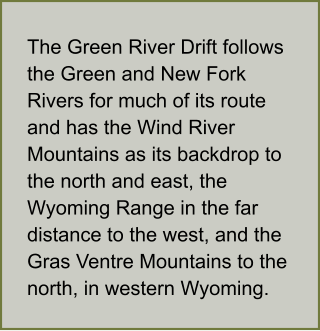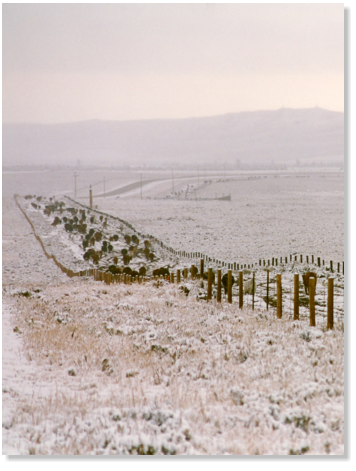
The Drift
For more than one hundred years, the Green River Drift has functioned as the essential connector between seasonal grazing lands for cattle ranches in the Upper Green River Valley. It provides the route for Upper Green River Cattle Association members and other area ranchers to trail cattle from spring grazing at the southern end of the Drift to summer and fall grazing at the northern end. In the fall, the cattle "drift" back to the south on their own back to their home pastures along the well-worn route of the Drift. Adult cows know the way, and confidently lead their calves and the younger heifers along. The Green River Drift Trail extends
for 58 miles, with an additional 41
miles of spurs, from high desert
mesas in the southern part of the
county to the Bridger-Teton National
Forest in the northern part of the
county.
Established by 1896, the Green
River Drift has functioned as the
essential connector between
seasonal grazing lands for cattle
ranches in the Upper Green River
Valley. The Drift continues to be
used by area ranchers as well as
those ranchers belonging to the
Upper Green River Cattle
Association to do their cattle
operations.
The path of the Drift made use of
natural features such as draws and
creeks to funnel the cattle onto a
common path and provide a stable
supply of water and feed. Overall,
the overall route and use of the Drift
today is very similar to its route and
use in its early history.
.
The Green River Drift Trail extends
for 58 miles, with an additional 41
miles of spurs, from high desert
mesas in the southern part of the
county to the Bridger-Teton National
Forest in the northern part of the
county.
Established by 1896, the Green
River Drift has functioned as the
essential connector between
seasonal grazing lands for cattle
ranches in the Upper Green River
Valley. The Drift continues to be
used by area ranchers as well as
those ranchers belonging to the
Upper Green River Cattle
Association to do their cattle
operations.
The path of the Drift made use of
natural features such as draws and
creeks to funnel the cattle onto a
common path and provide a stable
supply of water and feed. Overall,
the overall route and use of the Drift
today is very similar to its route and
use in its early history.
.

Ranches in the Upper Green River
Valley region are dispersed along
waterways and valleys that contain
irrigable land for producing hay.
Grazing land is located further out
on the surrounding mesa, desert,
foothill, and mountain pasture
based on a spring, summer, fall,
and winter feeding pattern.
In the spring, starting from May 1-
May 25, the cattle of the Association
members graze Bureau of Land
Management (BLM) allotments on
the Little Colorado Desert or the
Mesa. Spring grazing on BLM
managed land lasts about two
months - May through June.
Cowboys start removing cattle from
spring BLM pastures and trailing
them up to 60 miles north beginning
the middle of June and ending the
middle of July. There is a 3 to 4-
week period for trailing the cattle to
the mountains from the time they
are taken off the spring pasture until
they are on the pasture systems on
National Forest land. Each ranch's
cattle herd is on the trail
approximately two weeks.
Summer grazing begins June 16
and lasts through October 15 of
every year. Bulls are put in with
cows in June and early July for the
breeding season. The haying
season corresponds with the
summer grazing season.
As cold weather arrives in the late
fall, the cattle drift back out of the
forest on their own, moving south
back toward their home pastures.
Strategically located fences direct
their movement down to the sorting
grounds where they are sorted by
brand, rounded up and trailed to
their respective home ranches, and
shipped to market in October and
November.
In the winter, cattle graze on the
hayed pastures and meadows back
at the home ranch. As the pastures
become snow-covered, the
livestock are fed from the hay
supply that grew in the same fields
over the spring and summer. If a
ranch was not able to grow enough
hay for winter feeding all their cattle
for five to six months, they need to
either bring in additional hay to
supplemental feed or ship cattle out
so they don’t starve.









Green River Drift






Photos courtesy Upper Green River
Cattle Association
Some of the text on this page has been reproduced from the National Register nomination report:
http://www.cr.nps.gov/nr/feature/places/12001224.htm











